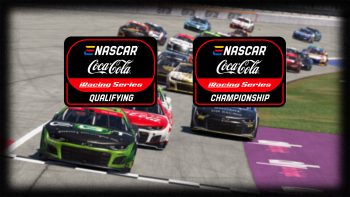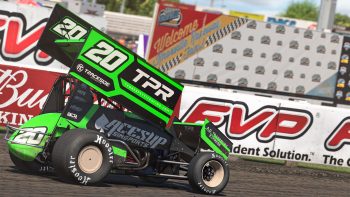
Making it Real
June 18th, 2014 by Jaime Baker
With more than 150 wins to his credits on the ovals and road courses of iRacing.com, it’s fair to say Scott Heckert is a serious sim-racer. It’s also fair to say he’s a very serious professional racer. A former karter and Skip Barber Racing School graduate, the Ridgefield CT native won Rookie of the Year honors racing Super Late Models in the 2012 Bright House Challenge Series. This season finds Scott driving for Turner Scott Motorsports in the NASCAR K&N Pro Series East where he has a pair of top ten finishes (including a third place at Iowa Speedway) and three straight top five starts to his credit.
iRacing has become an integral part of Scott’s pre-race preparations, and we’re delighted to announce he will be sharing his thoughts about the convergence of virtual and “real” racing with the readers of iRacingNews. Welcome Scott!
It’s hard to overstate what iRacing has accomplished in developing a passionate community and enabling tens of thousands of sim-racers around the world to participate in real competition. iRacing gets my heart pounding and that’s important; but what really sets the service apart from its competitors is the attention to detail. For a driver who has not had real life track time it can be hard to understand the authenticity created by iRacing’s laser scan technology. When iRacing says each track is modeled to its precise detail they are not over-inflating the truth: they are spot on.
Competing in the NASCAR K&N Pro Series East these past couple years, and this year for Turner Scott Motorsports, I’ve been fortunate enough to travel across most of the eastern half of the United States racing on tracks as small as Langley Speedway in Hampton, VA and as large and fast as Dover International Speedway in Dover, Delaware. In total, nine out of the 14 tracks on our schedule are offered on the iRacing service. This affords me the opportunity to make a couple hundred laps at the upcoming track to learn the line, bumps, and visual references. What I consider my diverse range of on track experiences, along with my five years of iRacing, provides me a unique perspective on what the service means to professional racers and auto racing enthusiasts alike.
Let’s start with New Smyrna Speedway. On the surface it is a very average short track with pretty steep banking in the corners that flattens quickly onto low-banked straightaways. At a half mile in length, New Smyrna is of average size but provides relatively high speeds due to the high level of grip. This track is more challenging then the synopsis would lead you to believe; in fact it’s a track that is highly dependent on line and brake application.
Turns 1 and 2 can be approached a couple different ways, depending on the handling of your race car. A higher entry will serve a car with understeer best while a car with oversteer likes a shallower line. The entry points may be different, but you are aiming for the same spot in the corner, which is about a groove up from the bottom. The grip is better here compared to the bottom because the track seems to flatten out quicker on the bottom. Driving a virtual Chevy Impala K&N car to the bottom on entry results in the car sliding up the track with loads of understeer. Now without changing setups, enter a lane higher and the car will rotate much better and pick up a good amount of rolling speed. I developed this line in my virtual car and it transferred directly when we unloaded in February. You hold your line a groove off the bottom all the way around the corner and drive the car as straight as you can up off Turn 2.
Turns 3 and 4 are handled differently for me with regards to line and braking pressure. In race trim I roll out of the throttle early and ease onto the brakes. The car rolls down to the bottom and is slowed by the banking and steering angle. Getting the left front tire as close to the white line as possible will help the car turn through both 3 and 4. When getting back to the throttle, you want to make sure the car is pointed as straight as possible as it rides over the minor bumps on the exit of 4. As the car tightens up mid-run, you can move that line up half a groove, but the setup is not right if you are any higher. This line is once again an adaptation of the line I was running in iRacing. The emphasis in the simulation is the same as real life, namely roll speed and corner exit.
Now I am no setup guru, but we fought the same problems in real life as I did in iRacing. The car would bounce back and forth between a touch tight in the center and free off. Regardless of setup the track leads to a tendency for free off because of the loss in banking entering the straightaway. Learning to drive straighter off the corner to avoid this is one of the biggest benefits I got from running virtual laps.
“Through iRacing I have been able to experience tracks before ever setting foot on the property. This allows me to get right up to speed as soon as practice starts. Not to mention it’s a blast!”
Next on the schedule was Bristol. Nothing can prepare you for the feel of Bristol. It is a track based in trust of your equipment, the grip in your car and your own talent. It’s similar to New Smyrna in some aspects but with steeper banking the feelings are exaggerated.
Let’s start with frustrations I’m sure everyone has faced in iRacing. Ever smacked the wall off 2 or 4 on a hot lap? Same exact thing happens in real life if you’re not up on the wheel. Even more disappointing is the lack of a reset button . . .
Once you get used to how the track washes away on exit you have to start to trust the grip that’s in the center. As you roll off of the throttle and approach the turn, the visual is exactly like iRacing and you think there is no way the car will get through the corner. Instead, it lands on the banking and grips up. It’s a really cool feeling that is unique to the fast places like Bristol and Dover. Although iRacing can’t simulate the g-force loading, the visual cues are similar and help a new driver trust the car. More amazing to me is how accurate each bump is modeled. I’ve spent several hours playing with setups trying to get my virtual car from hitting the ground in Turns 1 and 2. Low and behold, off the truck and onto the real track I sail it off into 1 and the car bottoms out in the SAME exact place. The accuracy is really impressive.

Bristol Motor Speedway is “a track based in trust of your equipment, the grip in your car and your own talent.”
The racing at Bristol can be a bit frustrating with our K&N cars. We run the middle groove to keep our momentum wound up (same line as in the virtual car) and it makes it pretty hard to pass. You ride and wait for a slight slip from the driver ahead so you can dive beneath them and try to clear them in one corner. If you don’t clear them it is likely they will drive back around you on that outside groove. This type of racing is pretty close to the door-to-door action found on the virtual track, and the tempers flare in the virtual garage just as they do in the real race.
Through iRacing I have been able to experience tracks before ever setting foot on the property. This allows me to get right up to speed as soon as practice starts. Not to mention it’s a blast! Look for the second installment in this series following this weekend’s race at Langley Speedway.















































